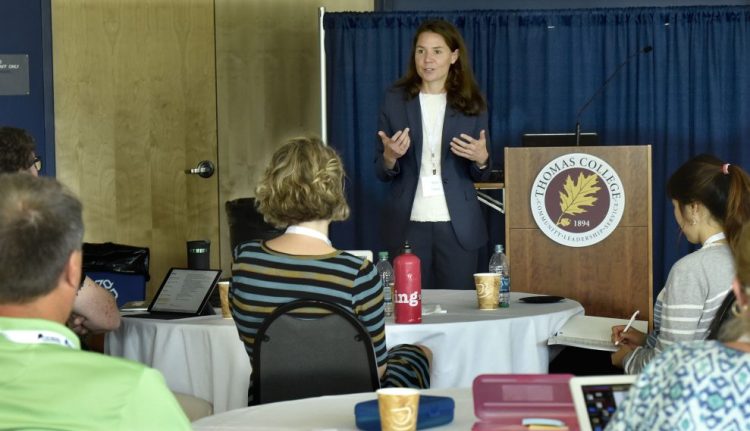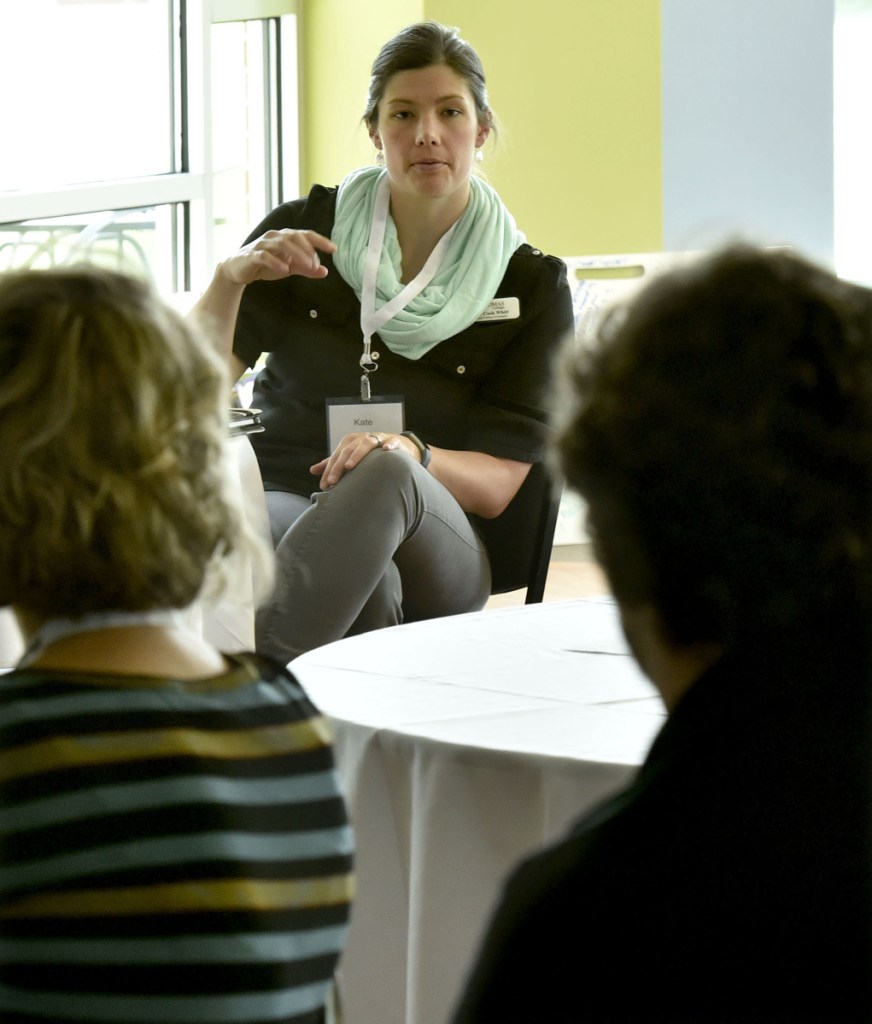WATERVILLE — The increasing growth of racially and ethnically diverse populations in rural places in Maine and beyond will keep these communities and their schools growing and thriving for decades to come. That growth also presents a danger of deepening inequality among races and social classes in these areas.
Schools and their educators, however, can find ways to offer equity to these diverse groups that are changing the demographics of rural communities and helping to stem the threat of dwindling population.
That’s according to Bates College professor Mara Tieken, who has focused much of her career on researching rural schools. Tieken discussed the changing face of rural education and the challenges these communities will face in the coming years Wednesday morning at Thomas College as part of the Center for Innovation in Education Summer Institute’s three-day conference on the future of education in Maine.
Tieken’s interest in this branch of education is grounded in her practical experience.
Her first classroom was a double-wide trailer outside a 100-year-old schoolhouse in Vanleer, Tennessee — a town with a population of 398.
She remembered the trailer had been there a long time as it sagged in the middle under the weight of her 16 third-grade students and their desks, backpacks and books. Every day during mathematics class a woodpecker would cling to the side of the structure and start pecking and hunting for insects in the rotting wood.
After three years, Tieken left Vanleer and studied at Harvard University, receiving her doctorate in education in 2011. In 2014, her book “Why Rural Schools Matter,” which detailed the ethnographic study she conducted of two rural Arkansas communities, was published.
During her speech and a smaller workshop Wednesday at Thomas, Tieken presented some of her research to a group of Maine educators, focusing on the different ways in which they could offer equity through practices and policies.
Rural schools are important, she began, because they are often the lifeblood of most rural communities. Nine million people are educated in rural schools. Often the largest employer, these schools define and sustain the communities, knitting together the social fabric, sustaining a culture and creating an identity for the town. They offer a source of political power as well as a check on the power of others.
But these rural schools are threatened financially and academically.
“Public education relies upon a fundamentally inequitable source — and that’s property taxes,” Tieken said. “So property-wealthy places can generate a lot more resources than property-poor places … like the old mill towns that we have here in Maine.”
Schools in property-poor areas rely more on state and federal sources, which are often tight. The pressure to close a school, she said, might be mounting from fiscal pressure, declining enrollment and low test scores.
CHANGING DEMOGRAPHICS
But what is the most urgent threat for rural schools, Tieken said, and what she thinks is going overlooked and unrecognized is the changing demographics and what that means for rural schools and for the country.
“At its core, our public education system is fundamentally inequitable,” she said. But as demographics change, rural inequality could increase if it is not met actively with precise policy and best-practice prescriptions.
A couple of contradictory myths inform how the public perceives rural America, Tieken said. One is the romanticized and idealized depiction seen in “The Andy Griffith Show” or Norman Rockwell paintings, suggesting that nothing ever goes wrong in small towns. Another is the idea that rural communities are “backwoods and backward” — havens of ignorance, lawlessness and rampant drug addiction fueled by reality television.
But a third — and what Tieken believes to be a more consequential myth — is the idea that rural America is white America. This particular narrative was amplified by media pundits in the wake of the 2016 presidential election, Tieken said.
“The truth is that it is much more racially and ethnically diverse than it’s made out to be. People of color make up 20 percent of the rural population. That’s 10.3 million people. These are people that are erased when rural America is being talked about.”
That population, she said, is growing just as quickly as diversity in urban areas. Additionally, the places where rural diversity is growing the fastest are communities that were settled by white people and remained mostly white for generations.
“Places like Maine,” she said. “Where I live now in Maine there are Somali refugees tending crops and growing meat. Up north in Milbridge, Maine, you’ll see signs in Spanish and you can actually get good Mexican food. That’s because Latino families were drawn to work in the blueberry industry or in lobstering. Those people are beginning to stay, and this is changing the demographics of Milbridge and other rural places.”
Herein lies the danger. As rural communities of color grow, so does the risk of increased racial and class inequality.
Rural poverty is already a dire issue in these communities, particularly persistent poverty affecting multiple generations, as is social class stratification.
But rural communities of color are even more at risk of living in poverty, Tieken said, which can be traced back to the forced migration, enslavement or conquest of communities of color in the United States.
Racial residential segregation, school segregation and unequal political representation are all challenges that follow and affect the funding and quality of rural education.
If educators don’t respond carefully, Tieken said, they could be complicit in perpetuating injustices.
SCHOOL SOLUTIONS
It doesn’t have to be that way, Tieken told the group.
She said there are three specific ways educators can step in and offer equity as a way to bridge the equality gap.
Building a strong relationship between the community and the school is the first step.
In Delight, Arkansas — one of the towns Tieken highlighted in her book — the school was a community center as well as a place of education. It was routine for the entire community not only to show up for school events, but also to socialize with people of all races and ethnicities.
Tieken said schools should open their doors so that the public feels comfortable being in the school. Another way to foster this relationship is to have community representatives and ambassadors to explain school budgets and other initiatives so that everyone is on the same page.
Another way is to pursue equitable teaching practices. Tieken said this entails difficult self-examination, asking which students the school might be underserving. She said educators need to figure out how they might be perpetuating problems and reinforcing the status quo.
All-white classrooms especially need to be talking about race so that they are not misrepresenting history or perpetuating stereotypes of people of color, she said.
Teachers can do that by building a curriculum that represents a range of people thoroughly and authentically, Tieken said.
Lastly, she said, teachers need to organize in order to push for more equitable practices.
According to Tieken, voices of rural educators are typically missing from policy conversations. Policies such as school choice and state funding hit rural communities of color the hardest.
She urged the educators to form diverse coalitions and build regional networks so that they are stronger when they go up against more powerful entities.
“We’ve seen what organized rural teachers can accomplish,” Tieken said, apparently referring to recent teacher walkouts for higher salaries.
“We need a core group of committed teachers leading it,” she said. “That’s where the work is; that’s where the equity matters most.”
Emily Higginbotham — 861-9239
ehigginbotham@centralmaine.com
Send questions/comments to the editors.




